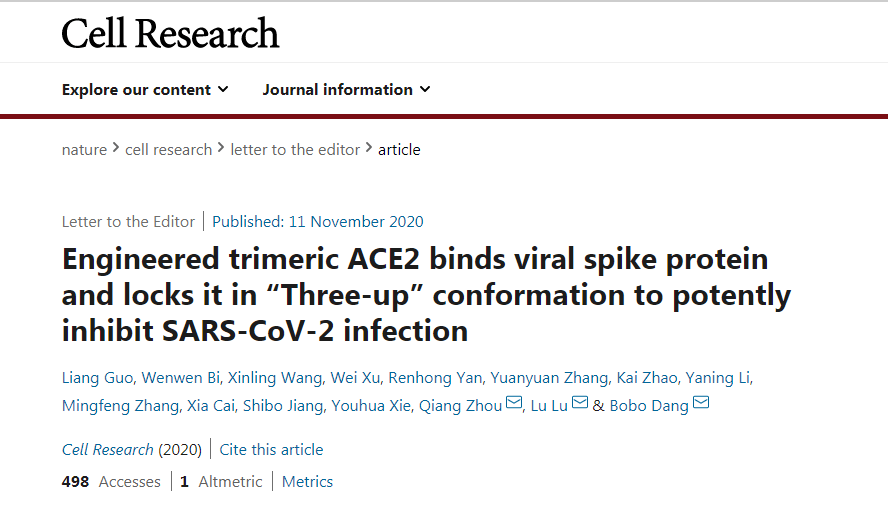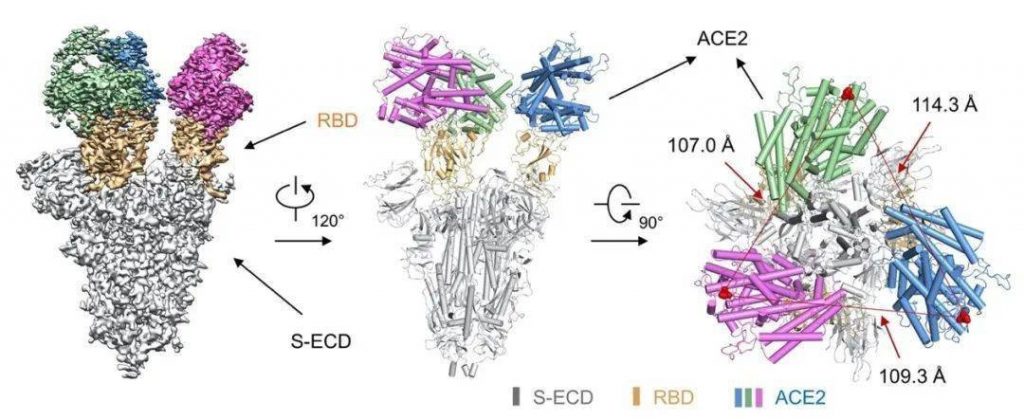COVID-19 Protein Inhibitor by China Westlake University
COVID-19 Protein Inhibitor by China Westlake University
COVID-19 Protein Inhibitor by China Westlake University. The COVID-19 (New Coronavirus) epidemic raging around the world is a common test for all mankind. Since the outbreak of the epidemic, scientists have been committed to understanding the mechanism of virus invasion and researching solutions. Vaccines and antibodies, as important means to prevent and treat COVID-19 pneumonia, have made great progress. In addition to these methods, are there other ways to effectively contain the new coronavirus?
Recently, West Lake University’s Dang Bobo team, Zhou Qiang’s team, and the Fudan University School of Basic Medicine Lu team jointly published the title Engineered trimeric ACE2 binds viral spike protein and locks it in “Three-up” conformation to potently inhibit SARS in Cell Research. -Research paper on CoV-2 infection.

Based on the design and modification of the new coronavirus receptor ACE2, they constructed a variety of ACE2 trimer proteins. Among them, T-ACE2 has an affinity for the new coronavirus spike protein to KD<1 pM, and greatly improves the virus inhibitory activity. In other words, this joint research team created an ACE2 prosthetic protein that “confuses” the virus, and its “attractiveness” to the virus is more than 1,000 times higher than ACE2 itself.
West Lake University distinguished researchers Dang Bobo and Zhou Qiang, Fudan University Lu Lu is the corresponding author of this paper, West Lake University Guo Liang, Bi Wenwen, Yan Renhong, Zhang Yuanyuan, Fudan University Wang Xinling and Xu Wei are the co-first authors of this paper.
Artificial design of ACE2 prosthetic protein “temptation” virus
Previous studies have found that the key to the new coronavirus infecting human cells is the combination of the spike protein of the coronavirus and the human ACE2 protein. To be precise, it is the spike protein that “hijacks” ACE2, which originally controls blood pressure, and invades the human body through its combination. Since the ACE2 protein is the gate for the virus to invade the human body, after the new coronavirus enters the human body, if we have an ACE2 prosthetic protein to “confuse” the virus, can we achieve the effect of suppressing the virus?
Based on this idea, Dr. Dang Bobo, who has been engaged in protein design and transformation for a long time, thought of building an artificial ACE2 prosthetic protein to bind the virus, so as to achieve the purpose of denying the virus enter the human body. Recent studies have shown that the new coronavirus spike protein exists in the form of a trimer, so the researchers envisioned that it is possible to construct an ACE2 trimer protein to achieve a 3-to-3 or at least 2-to-2 binding with the spike protein trimer?
Subsequently, the researchers studied the structure of the coronavirus spike protein in depth and made a series of design and modification attempts. They obtained a trimeric protein T-ACE2, which can reach KD with the new coronavirus spike protein. <1 pM, compared with the original ACE2 monomer, the affinity to the spike protein has increased by more than 1000 times. With high affinity, the virus will preferentially bind to T-ACE2, thereby losing the ability to bind to ACE2 on the cell surface, so T-ACE2 has a very strong viral inhibitory activity.
Although the spike protein itself exists in the form of a trimer, when there is no receptor binding, the three monomer structures in the trimer are different, and at most only one monomer in the trimer is in an open structure that can be interacted with.体合。 Body combination. The greatly increased affinity of T-ACE2 and spike protein suggests that T-ACE2 may induce conformational changes in spike protein. In order to further reveal the way T-ACE2 binds to the spike protein, the research team analyzed the electron microscope structure of the complex of T-ACE2 and the new coronavirus spike protein. The structure shows that T-ACE2 can indeed induce significant structural changes in the COVID-19 spike protein. The three monomeric proteins are in an open state at the same time and bind to three ACE2 at the same time.
“At the beginning of the design, we were not sure whether the ACE2 trimer would be effective, but what is more amazing is that after T-ACE2 is made, the affinity has really been greatly improved, and in the process of binding the spike protein It really induces a structural change in the spike protein so that it can firmly bind to the spike protein. Why this change occurs? It is not clear, but this should be useful for understanding the interaction between the spike protein and the receptor protein ACE2 There are important revelations. This unexpected phenomenon of T-ACE2 inducing the structural changes of the spike protein is also the most interesting part of this work.” Dang Bobo added.

T-ACE2 may be able to adapt to more new coronavirus-like viruses
With the normalization of the epidemic situation and the accumulation of virus mutations, the effects of existing protein inhibitors (such as antibodies) on the new coronavirus and its potential mutant strains are facing tests. The development of inhibitors that can broadly inhibit the new coronavirus and its mutant strains will become an effective means to deal with the mutation of the new coronavirus and the normalization of the epidemic.
In the process of designing and transforming the ACE2 trimer protein, in order to maximize the broad-spectrum applicability of the modified protein to the virus and its mutant strains, the researchers chose to completely retain the natural ACE2 sequence (1-615) because it is based on the natural ACE2 sequence The modification can be adapted to a variety of mutant viruses. In this study, the researchers also confirmed that T-ACE2 has strong inhibitory activity against the new coronavirus, 8 different natural new coronavirus mutants, SARS virus and two new coronavirus-like viruses, with IC50 values in the range of 0.1nM-3nM.
The new coronavirus infects human cells through the receptor protein ACE2. Therefore, inhibitors designed based on the receptor protein ACE2 have a broader spectrum of inhibitory ability against new coronavirus mutant strains than antibodies. In addition, such proteins designed and engineered based on the receptor ACE2 will also likely be used to inhibit new or recurring new coronavirus-like viruses. However, the clinical application prospects of T-ACE2 as a viral inhibitory protein still await further experimental verification in the future.
Dang Bobo said that because T-ACE2 has a very strong affinity with the viral spike protein, it is expected to be used in the development of virus detection methods, and because T-ACE2 is designed entirely based on the sequence of natural ACE2, it is similar to the COVID-19 The broad-spectrum applicability of the virus will be relatively high, and such T-ACE2-based detection methods will also be widely used in the detection of new coronavirus-like viruses.



